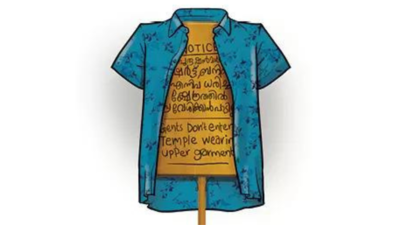The year was 1982. A scuffle broke out in the dining hall of the Guruvayur temple complex when those serving special free meals manhandled a person who refused to remove his upper garment. They demanded to know whether the person who sat among the sacred thread-wearing shirtless men was a Brahmin or not. For, it was a ‘Brahmin Oottu’ (meal) and those belonging to other castes were unwelcome. The person who challenged the custom was spiritual leader and social reformer Sree Narayana Guru‘s disciple Swami Ananda Theerthan, known for his relentless fighting against caste discrimination.
As news about the manhandling of Ananda Theerthan made headlines the next day, temple authorities and the govt faced severe criticism. The then chief minister K Karunakaran reacted swiftly. The practice of ‘Brahmana Oottu’ was abolished, and a mass feast organised in the same dining area. Karunakaran, along with several other community members including Dalit activist and writer Kallara Sukumaran, participated in the event.
However, the practice of some temples insisting that male devotees enter the temple with bare upper bodies continues to this day. Now, four decades later, a call by Satchidananda Swamy, head of Sivagiri mutt which was founded by Sree Narayana Guru, to do away with the shirtless tradition has sparked a fresh debate. Satchidananda Swamy put across his demand in the presence of Kerala CM Pinarayi Vijayan at the inaugural session of the annual Sivagiri pilgrimage. The mutt chief argued that the dress code had nothing to do with scriptures or spirituality and was a disgusting residue of casteism in Kerala. “Temples and deities are instruments that help devotees reach the formless and nameless God. It has nothing to do with the external appearance or the dress code of the devotees. What is going on in the devotee’s mind while inside the temple and in front of the deity is the only thing that matters,” said Swamy.
According to him, such dress codes were the invention of the clergy aimed at excluding non-Brahmins from temples. He pointed out that even some non-Brahmin priests were trying to enforce such Brahmanical traditions, including in some temples under the Sivagiri mutt’s administration.
Vijayan who, just a few days earlier attempted to disassociate Sree Narayana Guru from Sanatana Dharma, responded positively to Satchidananda Swamy’s call but with caution. He said the abolition of the dress code restrictions should be done only after reaching a consensus among temple stakeholders. The CM’s measured response was probably on account of the bitter experience his govt faced when it tried to implement the Supreme Court’s order permitting women of all ages to enter the Sabarimala temple.
“Satchidananda Swamy’s suggestion is a positive one. But the Devaswom board alone cannot take a decision. Consensus is essential,” said Travancore Devaswom Board president P S Prasanth, echoing the CM’s sentiment.
According to historian M G Sasibhooshan, the dress code might have originated as an attempt to discourage people from casually straying into temples or treating them as tourist spots. But he pointed out that such restrictions are prevalent only in Kerala or in a few temples like the Sri Mookambika Temple in Karnataka due to shared traditions with Malayali Brahmins. Most other Indian temples allow devotees to enter even the sanctum sanctorum without dress code restrictions.
Sasibhooshan also said the Kerala govt had made an abortive attempt to abolish dress code restrictions in the 1970s. The discussion took a contentious turn after Nair Service Society (NSS) general secretary G Sukumaran Nair came out against Pinarayi Vijayan’s support for Swamy’s proposal. Nair argued that temple traditions could not be altered by anyone, including the govt. He also questioned Satchidananda Swamy’s right to challenge temple practices. According to him, each temple had its own practices and traditions, and the dress code was an essential part of it.
The war of words continued as Sree Narayana Dharma Paripalana (SNDP) Yogam general secretary Vellappally Natesan launched a counter-attack on the NSS general secretary, saying such issues should not divide the Hindu community. Yogakshema Sabha president Akkeeraman Kaladasan Bhattathirippad struck a more conciliatory tone. He acknowledged that unnecessary restrictions and evil practices should indeed be abolished but stressed that changes must be implemented through broader consultation on a case-by-case basis.
He also rejected the argument that the dress code existed to help Brahmin priests identify their community members. “Customs and traditions vary across temples. For instance, Sabarimala temple has no dress code restrictions, and even non-Hindus are welcome there. But the same temple doesn’t allow women between 10 to 50 age groups to enter. We are not against change, but it’s unfortunate to attribute Brahminical hegemony to anything and everything,” he said.
The post Another reform vs tradition clash brews in Kerala over shirtless rule | India News appeared first on World Online.

